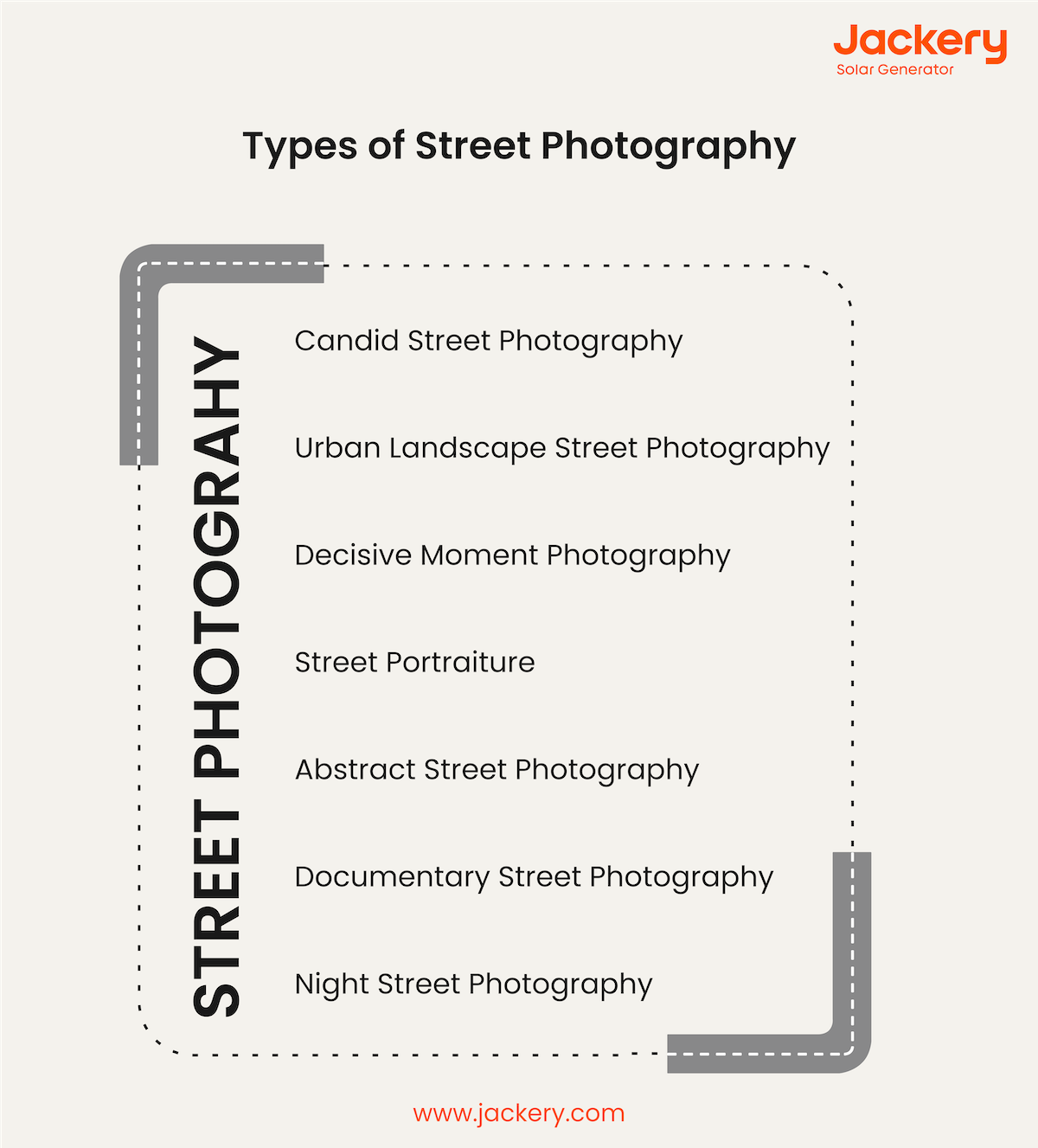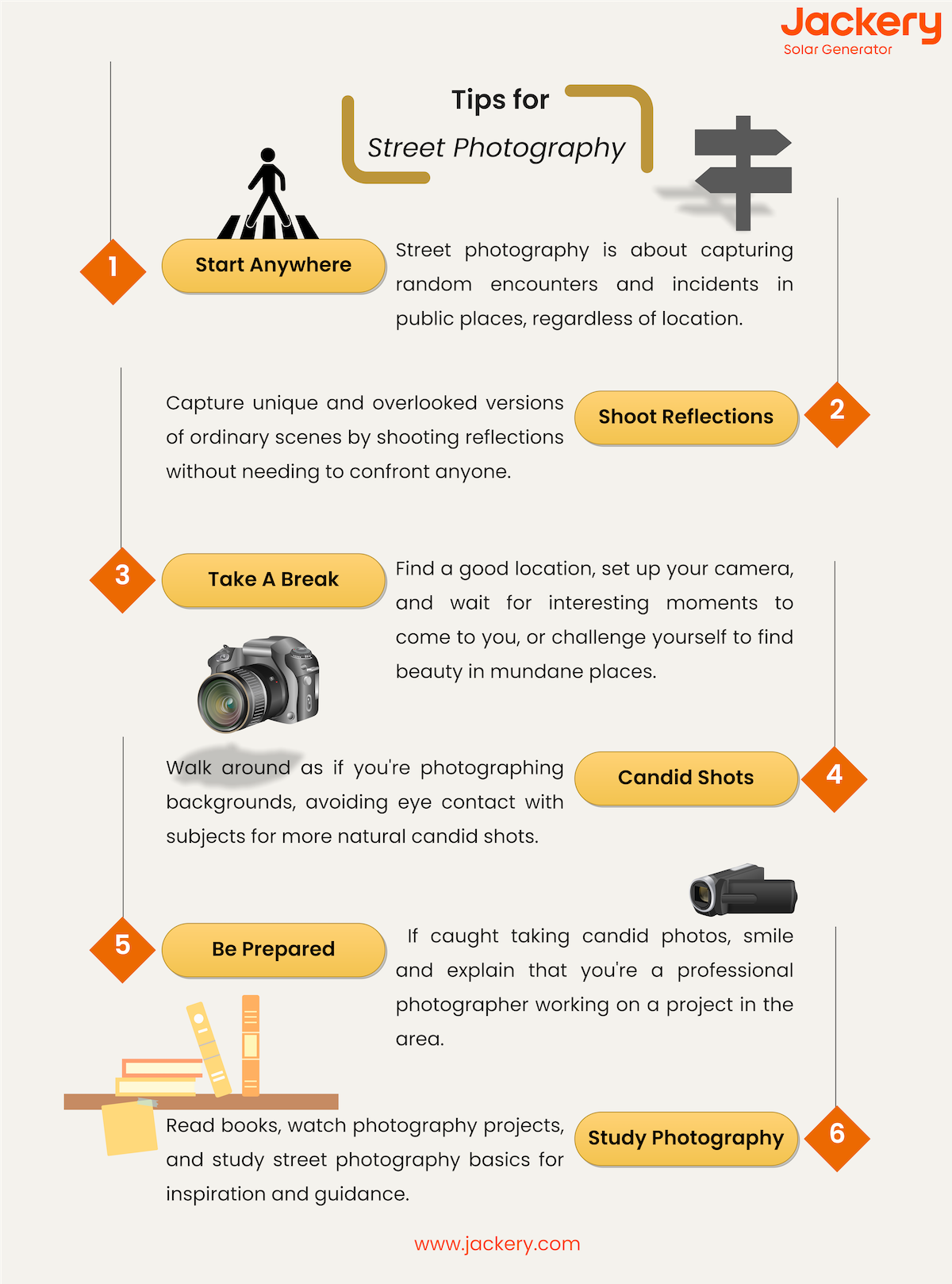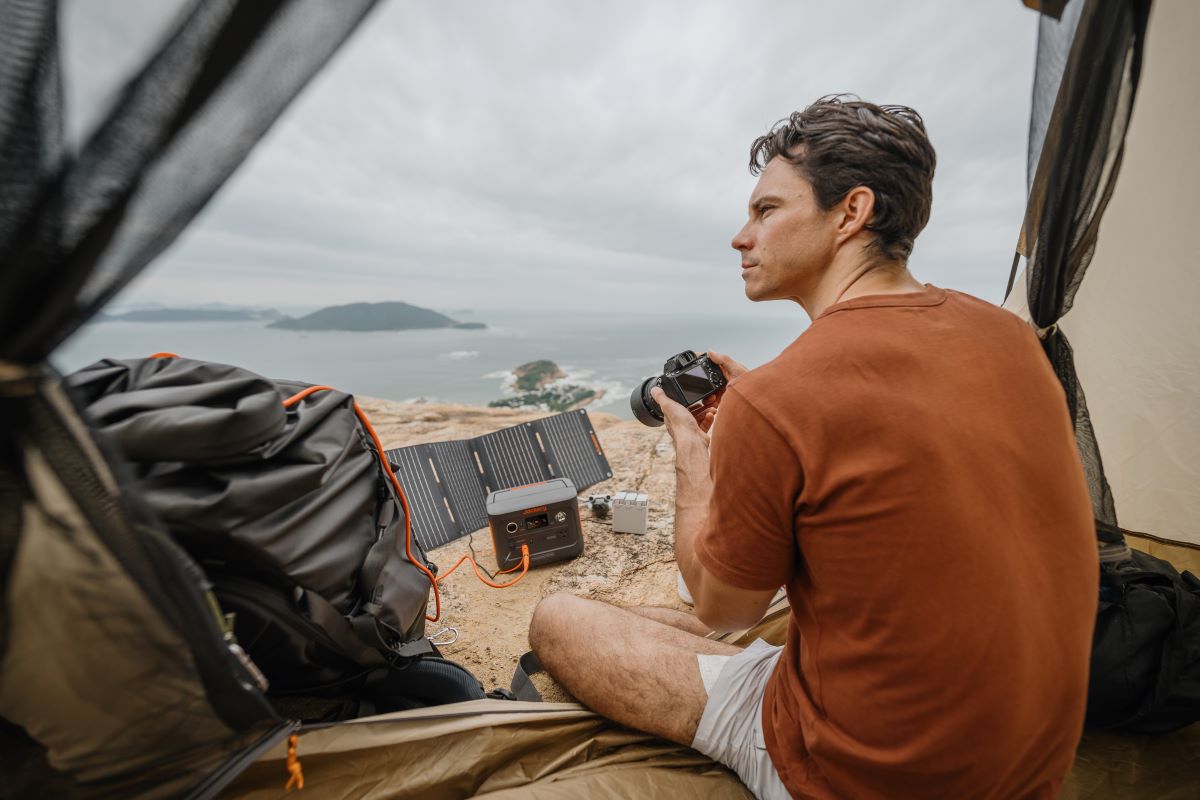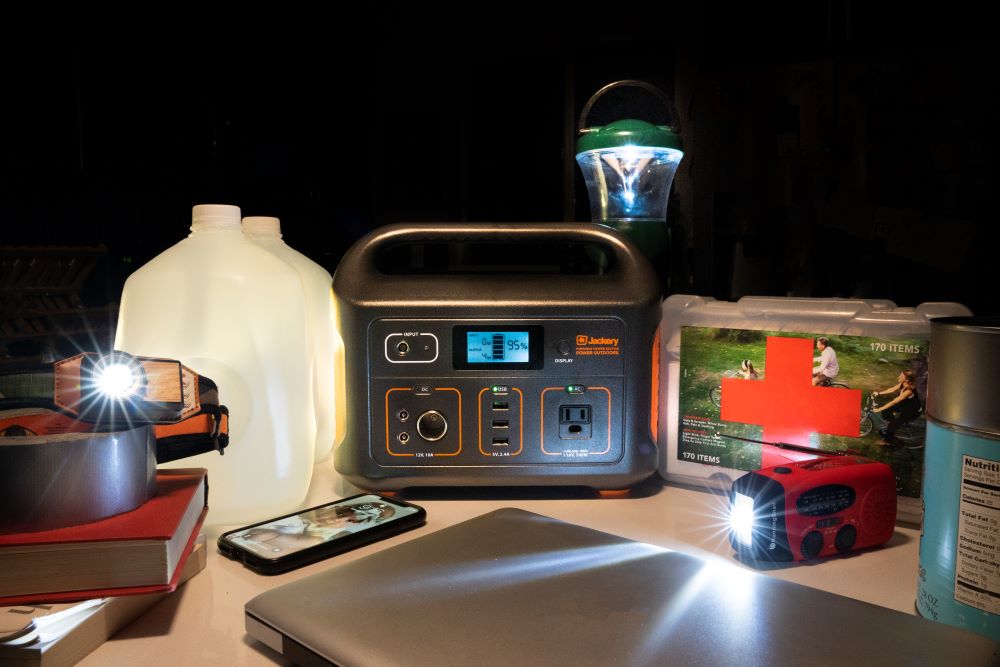Street photography is probably the most arduous yet fun genre of photography. Seeing what nobody else does and capturing magic moments requires years of hard work and patience. You must react intuitively and thoughtfully to draw viewers to your photos, just as in landscape photography. But despite all this, things go downhill if the equipment runs out of power.
This is where Jackery Explorer Portable Power Stations come into the picture. Their portability, high capacity, and quietness ensure to keep all your equipment running so you can only focus on capturing beautiful memories.
What Is Street Photography?
Street photography is a unique way of telling a story about one’s daily life experience and vision in the form of photos. But do we really need a definition? Yes, it allows us to get a clear understanding of what something is. Unlike nature photography, wedding photography, or others, the label “street photography” suggests it’s only limited to the streets.
But what is its origin? Street photography, since its start, has majorly evolved. Although it’s been there for ages, the French photographer Eugène Atget is most notable for his “Old Paris Series,” where he tried to capture the disappearing side of Paris amidst modernization efforts. And unknowingly, he paved the way for modern street photographers.
Nowadays, things have become much more straightforward. Everyone has a smartphone, and hence a camera, so you don’t need any powerful or expensive equipment. But that doesn’t make it less challenging.
Unlike photojournalism, nothing is always planned or relies on studio lights or models; artists just move around capturing what comes naturally to them. And unlike sports or landscape photography, you might not be clear about what you might click next.
You must work hard, be patient, and sometimes be brave to click photos of complete strangers! That’s not it. Questions and debates about respect and privacy are always there, as some might not want to get clicked without consent. In certain countries, you might even get into trouble for clicking street photos. While in others, you’ll get complete freedom.
But every coin has two sides. You can get a lot of compliments for your shots, you start seeing things differently, and for beginners, it truly hones your technical skills. So, it’s fun and rewarding as well.

Why Do We Need Street Photography?
As mentioned, street photography has its perks and can fulfill you in multiple ways. It’s worth exploring them as you might resonate with an aspect that further inspires you to head onto your next photo walk.
- Creative Expression: Street photographers shoot documentaries, portraits of strangers, coincidences, off-the-wall moments, architecture, abstract art, and more. So, you get to click something new every time you head out and fine-tune your skills or techniques.
- Explore the Unexplored: It’s probably what’s best about street photography. You might start to see things differently than others, and the more you explore, the chance is you’ll notice something extraordinary that seemed typical at first.
- Capture a Piece of History: Who knows, you get to capture something like Atget recorded Paris, and that’s invaluable. You don’t need to be an exalted figure to contribute something to the genre.
Types of Street Photography : Street photography is a multi-faceted genre, each of which is exciting and easy to get grips with. Let’s take a look at them:
- Street Fashion Photography : Street Fashion Photography is something many photographers prefer these days, as you save on lights, studio rents, and other expenses. Decide on an ambient location, time, a proper background, and the right settings to click equally aesthetic photos.
- B&W Street Photography : This subgenre of street photography lets you capture the essence of a scene, where colors can be distractions. It’s a bit different from clicking a traditional street photo.
- NYC Street Photography : New York City and street photography are like bread and butter. With such diversity here, every day and every corner of the city is new. You’ll find multiple authentic and impressive areas here.
What makes good street photography? Although one doesn’t need much apart from a good camera to be a street photographer, social media is filled with subpar and mediocre clicks. So the question is, what is street photography that’s good? The answer is simple: Try telling a story with your clicks. Create something that catches an eye and raises questions.
Besides, there should be a clearly defined portrait, and the composition rules like symmetry, frames, rule of thirds, leading lines, etc., still hold.
What Equipment Is Needed for Street Photography?
It’s true that you don’t need any expensive or powerful equipment for street photography, but some cameras do deliver a definite advantage. SLRs (Single-Lens Reflex) are fast but are big and heavy, so spontaneous or quick clicks can get tricky. Grab a prime 35mm or a 50mm lens if you must use one. These lenses lighten up your camera and when you use a single-focus lens, your skills will go up by a notch.
With no zoom lens, prepare yourself to lose some shots, but once you get used to it, you can capture instant shots. It further helps you focus and become more consistent with your shots.
The best to have, however, are mirrorless or even micro 4/3rds cameras, as these are smaller and lighter than SLRs and perfect for street photography. They also have faster shooting speeds and better video capabilities. However, they have limited battery life and higher price points.
Or you can just use your smartphone. Cameras in these have come a long way, and you can get nice shots with decent settings in place. You will also need a portable power source, like Jackery Solar Generators or Jackery Explorer Portable Power Stations, to charge outdoor appliances, like cameras, mobile phones, etc., for long hours.

Now, let’s talk about camera settings : Street photography is all about intuition. Your eyes must catch the creative second that life offers you, and that’s the moment when a photographer is creative. Once it’s gone, it’s lost forever.
It’s thereby pivotal that you’re ready for these moments, and the first step of this journey is to get your basics right and ensure your camera won’t let you down. As you get proficient with camera settings, your shots improve automatically.
Every photographer has their preferred mode of shooting, from relying on auto to manual and everywhere in between.
Let's start with aperture priority. It lets you click moving objects, reduce motion blur in low light, and capture less light on a sunny day. All you need to do is set the aperture depending on the depth of field and subject matter and let the camera perform magic. For example, if you want a scene in focus, set it to f5.6 and above.
Next is shutter speed. It’s what determines how good your spontaneous clicks look. If you’re clicking a moving person on the street, keep the shutter speed of 1/125 to ensure the subject isn’t blurred or frozen in motion. And at night, keep it 1/250 or faster.
Another popular setting is to keep your lens focused on its hyperfocal distance rather than shooting with autofocus. It increases the focus on the scene.
Street Photography Tips & Ideas
The more you head outside and click random shots by adjusting the settings, the easier you’ll find moments worthy of capture. Also, the important thing is not to beat yourself up when you get home roaming all day without a proper shot. Rome wasn’t built in one day, and becoming a good street photographer takes time. Here are a few prompts for you to start your journey:
Where To Start
The answer is you can start at any time, anywhere. Even if you don’t have the luxury of clicking beautiful streets and culture in New York or street performers in Vegas, there’s a chance you’ll still find something gorgeous. Street photography is about anywhere you live. All you need is random encounters and incidents in public places; unless you stay in a mountain cabin, it’s easily accessible.
It’s important to head outside for around an hour and take random shots. Or you can just observe people. Look at their expressions and you’ll automatically get drawn towards the subject.
Shoot Reflections
For starters, shoot reflections. As you aren’t pointing the camera at someone, you don’t need to convince or confront anyone. What it does is create a unique and overlooked version of ordinary scenes. However, make sure to keep your camera always dialed in so as not to miss those creative seconds in your daily lives.
Take A Break
Everyone just wants to move around to a spectacular location, but that’s not always important. You just need to find a good location, set up your camera, and wait for things to come at you. What’s even better is, people intentionally enter into your personal space, making the dynamics much easier.
You can also take this technique to another level by staying where you are and not disregarding anything. Often, many good photos remain hidden in most mundane places and are things you see day and night. So, if you find yourself in an area where no scenes are good to click, take this as a challenge to see what’s under your nose. Who knows, you might get a surprise.
Candids Are Often Better
What makes street photography unique from other genres is no planning involved. All you need is just to head out and start taking shots.
So here’s a tip as to how you can take better candids: Walk around pretending you’re clicking backgrounds and aren’t noticing people around you. Try not to make eye contact with your subject and click quick photos before they could notice what you’re doing. This way, pictures look more natural.
And what if someone catches you? Just smile and clarify that you’re a professional photographer who’s doing a project in the area that requires you to capture a scene the way it looks. Think ahead about what to answer if someone asks you. This often goes a long way and ends in a pleasant conversation.
Read Books and View Street Photography Projects
You’ll find various journals and books on various internet sources that encapsulate the basics of street photography alongside photo samples. It’s recommended to read them thoroughly, watch multiple photography projects, and work on clicking similar photos. It’s beneficial even if you’re doing it for quite a long time. You can get inspiration.

Street Photography Rules
There aren’t any thumb rules in street photography, but you must be aware of ethical considerations whilst photographing in public. In this way, you can create work that’s respectful to people around you and, in turn, refine your skills over time.
General Code of Conduct
For the most part, street photography is legal in the US, with a few exceptions. Take shots in private grounds or owned public spaces like malls, libraries, and others, and security personnel will approach you. Irrespective, it’s important to stay updated with the latest rules and regulations to be answerable when someone challenges you.
But if something legal doesn’t mean it’s ethical, especially when taking photographs of children and/or women. In the case of children, their parents are right to question your actions as they don’t know where you’ll use the photos. The same goes for women. It’s important to introduce yourself to the guardian of the kid or the lady and ask for permission.
In this way, you make sure not to find yourself in a sticky situation. And if you still do, ease the confrontation by deleting the photos.
Overcome Your Fear
Street photography can be daunting, especially if you’re shy. Don’t just throw yourself at strangers at first; rather, start small. For starters, sit outside a cafe and use your smartphone to click pictures around you. Then bring your camera and get used to handling it in public. Try to calm down, capture the essence and details of a scene, and slowly start including people in your photos if you wish.
Approach With Kindness
General courtesy dictates that someone should know that they are being clicked, and so taking their permission becomes quintessential. Try approaching them with a smile, explain to them who you are and why you want to take their photo. It is enough on most occasions.
Besides, you can show your work on your social media page and promise to share their photos once completely edited. Not everyone will say Yes, and that’s okay. Don’t take it to heart, smile at them and move on. Just keep trying.
How do Jackery Portable Power Stations Help for Street Photography?
Jackery is a global brand that manufactures and sells solar generators, power stations, and solar panels. The Jackery Explorer Portable Power Station with its high-capacity battery, comes as a powerful charging solution for photographers.
While photographing, you move to certain locations without access to electrical outlets. That said, carrying a power source is important to keep your equipment, like cameras, laptops, etc., charged. After all, you can’t afford to miss a shot.
The rechargeable batteries of Jackery Explorer Portable Power Stations store energy that you can use while on the move. That’s not it. These are much quieter than traditional generators, so you can keep your items powered up without sacrificing the tranquility of the outdoors.
Other than that, their small size (even fits in your bags), efficiency, and safety features make it a great choice for street photographers without having to worry about getting shut off due to low battery.
Jackery Explorer 300 Plus Portable Power Station
Jackery Explorer 300 Plus Portable Power Station is a great option if you need to purchase a power station for a short trip. Its LiFePO4 battery, with its 288 Wh capacity, can power up most of your equipment (prime lens, portable LED light panel, portable printer, laptop, etc.) for hours.

Customer Review
“First test, I ran my 37 QT 12V fridge/freezer on Eco mode for 7 hours. At the end of the test, Jackery was still at 28%. Very happy with it for the price and capability!”- Alan Wells.
Jackery Explorer 500 Portable Power Station
If you’re looking for an increased performance that won’t hurt your wallet much, then Jackery Explorer 500 Portable Power Station is your best bet. It’s the same size as a basketball and features an easy-carry handle, making it an ideal companion for your photography travels. And with a 518 Wh capacity, you can expect to charge appliances for long hours.

Customer Review
“Recently made the purchase. I've used it to charge phones and run an electric fan. I will be camping when the weather warms up a little. It has worked well. The solar panel charging will be nice when I'm out camping .” - Tim.
|
|
Explorer 500 Portable Power Station |
Explorer 300 Plus Portable Power Station |
|
Capacity |
518 Wh |
288 Wh |
|
Battery Cell |
NMC |
LiFePO4 |
|
Cycle Life |
500 cycles to 80%+ capacity |
3000 cycles to 80%+ capacity |
|
Recharging Methods |
AC Adapter : 7.5 H Car Adapter : 7.5 H Solar Panel : 9.5 H (1 x Jackery SolarSaga 100W Solar Panel) |
AC Adapter : 2 Hours Car Adapter (12 V) : 5.5 Hours Solar Panel : 9.5 Hours (1 x Jackery SolarSaga 40W Solar Panel) USB Recharging : 2.8 H |
|
Output Ports |
AC Output (x1) : 110 V, 60 Hz, 500 W; DC Output (x2) : 12 V⎓7 A USB-A Output (x3) : 5 V⎓2.4 A |
AC Output (x1) : 120 V, 60 Hz, 300 W (600 W Peak) USB-A Output (x1) : 15 W Max 5 V⎓3 A USB-C Output (x1) : 15 W Max 5 V⎓3 A USB-C Output (x2) : 100 W Max, 5 V⎓3 A (5 V, 9 V, 12 V, 15 V, 20 V up to 5 A) |
|
Working Hours |
Digital Camera (20 W) : 22 H External Flash (50 W) : 8.8 H Portable LED (50 W) : 8.8 H Laptop (100 W) : 4.4 H Portable Printer (150 W) : 2.9 H |
Digital Camera (20 W) : 12.2 H External Flash (50 W) : 4.8 H Portable LED (50 W) : 4.8 H Laptop (100 W) : 2.4 H Portable Printer (150 W) : 1.6 H |
Street Photography FAQs
What size of power station do I need for photography?
It depends on the number of equipment you carry along and the number of hours you’re out clicking pictures.
Let’s assume you carry a laptop (100 W), a Portable printer (150 W), and a portable LED (50 W) for your street fashion photography and run them simultaneously on Jackery Explorer 500 Portable Power Station.
The number of hours it runs is calculated as : Battery Capacity * 0.85 / Operating Wattage of Appliances = 518 Wh * 0.85 / 300 W = 1.72 H.
What is considered street photography?
Street photography is a genre that records things that happen in daily life in a public place. The public nature lets a photographer click a candid picture of strangers without them knowing.
What is the difference between street photography and snapshots? What about street photography and travel photography?
|
Street Photography |
Snapshot |
Travel Photography |
|
It is a genre that involves documenting and capturing everyday life. |
Snapshot typically involves capturing everyday life. |
Travel photography is a broad genre that involves clicking pictures when one travels. |
|
It is usually done in black and white. |
It can be done in colors or black and white. |
It’s typically done in color. |
|
Street photography involves the journey from amateurs to professionals. |
It’s often taken by amateurs. |
Travel photographers are professionals. |
What are the three major rules of street photography?
Three major rules of street photography are: when in doubt, don’t click, never click photos without consent, and overcome your fear.
Is street photography legal in the US?
Yes, street photography is legal in most places in the US, except private parks and establishments.
Final Thoughts
There’s a lot to learn about street photography, so save the article and come back later. Most important part of being good at it is to shoot more. Better you handle a camera and understand what’s around, you can capture those spectacular moments much better. Also, it’s important to relax, be spontaneous, and enjoy your time clicking.
To spend more time outside, a powerful Jackery Explorer Portable Power Station is always beneficial. Their high battery capacity and portability let you store the charge and use them while on the move.
Learning Resources
Books
1. Street Photography Now by Sophie Howarth and Stephen McLaren2. The Street Photographer's Manual by David Gibson
3. Henri Cartier-Bresson: The Decisive Moment by Cartier Bresson
4. The Street Philosophy of Garry Winogrand by Geoff Dyer and Garry Winogrand
5. Find Your Frame: A Street Photography Masterclass by Craig Whitehead and Kai Wong
Documentaries
1. What Makes a Good Street Photograph? - Take it or Leave it with Bruce Gilden2. Masters of Photography: Lesson 6 with Steve McCurry - Street Photography: Great things
3. Field Notes #1: Start by saying hello
4. Andre Kertesz BBC Master Photographers (1983)
5. William Klein - Photographer Technique & Process





















































































































Leave a comment